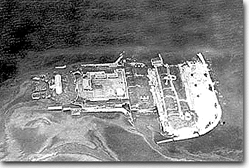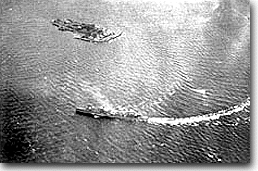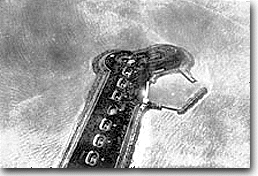The Great Kanto Earthquake
The No.3 Sea Fort suffered the damage the most
The Great Kanto Earthquake struck on Taisho 12 Sept. 1st (1923). This also damaged the Tokyo Bay Sea Forts.
The shallow water depth of the No. 1 sea fort was slightly damaged while the No.3 sea fort of deep water depth was severely damaged. The No.2 sea fort, which had a medium water depth, suffered medium damage. Most of the concrete structures of the No.3 sea fort were fallen or tilted into the sea.
However, due to good measures against non-uniform subsidence, no single crack were found in military facilities and buildings.
This is the photo of No.3 sea fort damaged and sunken after the Great Kanto Earthquake.
This is the only picture that shows the whole picture of the No.3 sea fort.

Immediately after the earthquake
Taisho 12 Sept. 9th (1923)
Yokosuka Naval Air Corps photography
National Institute for Defense Studies collection

Imperial flag ship “Yubari” and the No.3 sea fort
Photographed on Taisho 12 Sept. 9th (1923)
National Institute for Defense Studies collection

No.1 Sea Fort immediately after the Earthquake
National Institute for Defense Studies collection

No.2 Sea Fort immediately after the Earthquake
Photographed on Taisho 12 Sept. 9th (1923)
National Institute for Defense Studies collection
The No3 Sea Fort, a pioneer of Artificial Island construction
No.3 sea fort suffered the most damage
The No. 3 sea fort subsided for 4.8m, and one-third of the facility were sunk and lost its function, so cannons and military facility were removed.
The No.3 sea fort was not restored because of the advancement of artillery technology and the battery at the No.3 sea fort location was no longer needed.
However, those experience of design and construction were remained as great lessons for the subsequent marine port construction works, and left many useful suggestions.
The Tokyo Bay sea forts had a great significance as a pioneer of the construction of artificial Island, which is currently being carried out at ports throughout Japan.
